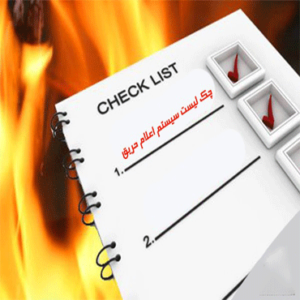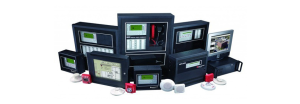Maintenance and repairs of fire-fighting system
We are all familiar with the three factors that cause fire, i.e. heat, combustible material and oxygen, and we know that as long as these three factors are together, there will be a possibility of fire and its continuation, so we should start a fire for prevention and if it occurs It was ready to prevent progress and continue burning. To achieve this, it is necessary to implement different types of fire alarm and extinguishing systems in different buildings, but more important is the readiness of fire fighting system in times of fire and performing their assigned tasks in the event of danger. Therefore, after the correct implementation of these systems, their periodic maintenance and repairs, periodic handling of perishable equipment and their readiness for work are of great importance.
Hamiyar Energy Company, by having skilled experts and technicians in the field of maintenance of fire alarm and extinguishing systems, has been able to achieve excellent satisfaction from its customers in addition to providing appropriate and professional services in this field.
Below is a summary of Hamyar Energy’s maintenance and repair plans.
Maintenance and repairs of fire extinguishing systems:
As you know, maintenance refers to the set of activities and actions to keep the equipment ready to work at an operationally acceptable level (maintenance) or to return defective equipment to the cycle of use and operation, and the expected result Among these measures will be preparation, maintenance of operational capability, continuity and operational continuity of equipment for defined conditions.
The NFPA25 Standard for Inspection, Testing and Maintenance of Water-Based Fire Protection Systems fully deals with the inspection, testing, maintenance and repairs of this equipment and describes all the necessary measures to prepare and maintain the system in the same condition and performance level as designed. .
In the wet pipe sprinkler system, the sprinklers are connected to the piping network containing water, and as soon as the sprinkler is activated, the water is drained immediately. The advantages of this system include high speed and low installation, maintenance and repair costs. In most areas where there is no risk of water freezing, the wet system will be the first choice of the designers, and ensuring the correct performance and maintaining the optimal conditions of this fire extinguishing system can only be achieved by carrying out a correct maintenance and effective repair process.

Inspection, testing and repairs
1- Inspection
– Sprinklers: Sprinklers should be visited annually and should be free of any corrosion (rust), paint, foreign materials and physical damage and should be correctly installed according to their type (e.g. upright, pendant or sidewall). If they have any of the above problems, they must be replaced or corrected, and any obstructions and blockages in the spraying path must be removed.
Regarding the service and maintenance of spare parts and stock, the following should be checked annually:
Appropriate number and type of sprinklers.
Special wrenches for screwing all types of sprinklers used in the system.
Pipes and fittings (Pipe & Fittings): Pipes and fittings used must be checked every year and in good condition. It should be free from any mechanical damage, leakage, corrosion and misalignment (non-compliance) and no external load should be imposed on them.
Hangers and Seismic Braces: The type and size of the pipe, the type of building materials, the probability of an earthquake, etc. are among the factors that affect the choice of the type of fasteners and the distance between them. In the inspection process, it should be noted that none of the holders should be physically damaged or loose. In case of damage or looseness, the necessary action is to replace or close them again.
Gauges: All pressure gauges must be visited monthly to maintain their proper condition and accurately show the water supply pressure from the network.
Buildings: Annually and before the start of the cold season, all parts of the building where the sprinkler fire extinguishing system is installed, including wall and ceiling windows, doors, ventilation system, vents, etc., should be inspected to ensure that the water Available in the sprinkler system, it is not frozen and the amount of heating (energy) required to create a minimum temperature of 4.4 ⁰c is available.
Alarm devices: These devices, including: mechanical alarms and pressure switches, etc., must be visited every three months and their accuracy must be verified without any physical damage.
Hydraulic system (Hydraulic nameplate): should be checked once every three months.
Firefighting connections (Hose Connections): be visited and controlled according to the annual standard.
Control valves: It should be noted that at least one listed control valve must be installed on each sprinkler system. Unless the feeding pipe of the sprinkler system and the firebox water network (systems consisting of piping network and fire hose connections used for manual extinguishing) are common. Then a control valve should be installed for each floor so that during the sprinkler system repairs, there is no disruption in the operation of the firefighting water network. The above valves, including butterfly valves, etc., should be checked weekly and monthly.

2- Test
Sprinklers: High-quality sprinklers will work well for up to 50 years if there is no possible physical damage and do not need to be tested. But after that they should be replaced or tested. In the second case, randomly from different areas, a specific number is selected as a sample and sent to a competent laboratory in the field of performance control and testing of this equipment. After approval, they will be usable, and after that, this process will be repeated every 10 years. If 75 years have passed since the construction of the sprinkler, the interval of each control will be reduced to 5 years.
Gauges: These equipment must be replaced every 5 years or compared with a calibrated sample, so that it can be sent to the calibration unit and corrected if it is not accurate enough.
Alarm devices: These devices should be visited every three months and their accuracy confirmed without any physical damage, according to the process mentioned in the standard, they should also be functionally tested.
Hose Connections: After 5 years of installation, this equipment must be serviced and if approved, every 3 years thereafter.

3- Repairs
In the repair department of fire extinguishing systems, the following things are done:
– Sprinklers: In some components of sprinkler systems, the reconstruction of the collection is done in the form of equipment and parts renewal. The following specifications and items are considered in the replacement and proper use of sprinklers:
– Sprinkler type
– Orifice size and coefficient k
– Temperature rate
– Sprinkler cover (if any)
– Spray type (upright, pendant, sidewall)
– Design requirements
A number of spare sprinklers according to the types used in the system should be kept in a special box. The location of the above box should not be exposed to humidity, dust, corrosion, or temperature exceeding 38 degrees Celsius. In no way should sprinklers with coating or paint or any additional and non-standard decoration be used. The status of the number of spare sprinklers that must be stored and available is as follows:
– In systems with less than 300 sprinklers, at least 6 sprinklers
– In systems with 300 to 1000 sprinklers, at least 12 pieces
– In systems with more than 1000 sprinklers, at least 24
Sprinkler Wrench: Sprinkler wrench is one of the important and required tools in the repair process. For each type of sprinklers installed in the system, there must be a special wrench in the spare parts storage box to be used during the assembly and disassembly of sprinklers and wrenching.
Installation approval test: When performing renovation activities and repairs of sprinkler fire extinguishing system components and equipment, resulting in an impact on more than 20 sprinklers, the installation and commissioning of all the above elements must be done according to the standard (NFPA13).
– Firefighting connections (Hose Connections): After each use of this equipment, all connections must be drained, cleaned and completely dried before being reused in the system. Equipment that fails to obtain approval in the inspection and testing stages must be repaired, tested or replaced again.
– Valves: This equipment is one of the most key components used, which should be repaired and maintained annually or whenever needed, and sometimes their internal elements should be visited.
– Water used in the system (Marine Systems): Usually, in sprinkler fire extinguishing systems, after repairs, fresh water is used as a reserve source for emptying and refilling the equipment.

Conclusion
Here, a little was discussed about how to inspect, test and repair water fire extinguishing systems (WET SYSTEM) based on approved standards, and the general plan and the importance of having a consistent and correct program in this area in order to increase the efficiency of the systems were determined. Therefore, the company Hamiyar Energy plans the maintenance and repairs of fire extinguishing systems according to the various conditions in the building.
Maintenance and repairs of fire alarm systems:
The readiness of the fire alarm system is of particular importance as the first and most effective fire detection and notification system to the residents of the building.
In general, the design, implementation and operation of the fire detection and notification system is done for the two purposes of protecting people’s lives and property. According to the national building regulations, topic 13 and the regulations of the fire department, fire alarm systems are divided into different categories.
1) Manual systems:
In these systems, only fire alarm buttons are used for notification
2) Automatic systems:
1- conventional
2- Addressable
3- Smart
A) The manual type is used only for buildings up to four floors that do not have an elevator.
b) Installation of automatic fire alarm system is mandatory for all buildings above four floors that have elevators.
c) Installation of automatic fire alarm system is mandatory for all public-commercial-cultural-educational places.
Rating systems:
Manual: fire alarm use only
Automatic: manual automatic detection only for spaces with high fire risk
Manual automatic detection of escape routes
Manual automatic detection of escape routes and rooms leading to escape routes
Manual, automatic detection of areas with high fire risk and sleeping areas
Manual automatic detection of all spaces
zoning:
Ease, speed and accuracy in detecting and determining the location of fire, especially in large buildings, creates the need to divide the building into smaller and separate areas.
In conventional buildings, we usually consider each floor as a protection zone.
In large buildings with high floors, one floor can be divided into several protective floors.
False alarm:
One of the problems of automatic fire alarm systems is the sending of false alarms, which reduces trust in this system if repeated.
Error messages can be classified into five groups:
1- Error warnings caused by things like cooking, cigarette smoke, car exhaust smoke, dust
2- Warnings caused by faults in the network
3- Error warnings caused by exposed actions such as breaking fire alarm glass
4- Unknown error warnings that cannot be placed in any of the above categories
In conventional systems with 40 vectors or less, sending two error messages per year is considered normal
Types of automatic fire alarm systems:
1- Conventional systems
2- Addressable systems
3- Intelligent systems
Conventional fire alarm systems:
In this system, several detectors that cover an area of the building are interconnected in the form of a circuit and connected to the central control panel, so each circuit represents an area.
The method of connecting the detection and detection equipment to the central control panels is branched and radial. Any conventional central control panel can be 4.2-12.8-16-zone.
Open circuit, normal, alarm and short circuit modes are the four states that any fire alarm system can assume. Each of these modes is determined by decreasing or increasing the current range, so it is necessary to establish a continuous current in the entire circuit so that by changing its range, the central control panel is able to determine different situations. The necessity of establishing such a current causes a The resistance at the end of each circuit should be used (4.7-6.8).
Different modes of fire alarm systems:
1- Open circuit: If the circuit is interrupted at any point, it will reduce or cut the continuous current, this will be sensed and announced by the central control panel.
2- Normal conditions: the detectors pass a very small current, which is the continuous current
3- Warning conditions: in case of fire conditions and the detectors are activated, the current passing through them increases and may reach up to 50 mA.
4- Short circuit mode: In the event of a short circuit in the circuit, the potential difference reaches zero and the passing current increases greatly.
There should not be more than 30 detectors and tests in each conventional zone or branch circuit of a zone.
Fire fighting systems, addressable fire alarm:
The principles of fire detection and detection in addressable systems are similar to conventional systems, except that in such systems, each of the automatic detectors or sensors has a unique address through which the control panel is able to identify it.
The detection circuit in such systems is circular, which starts from the central control panel and ends at the same panel
All equipment is placed in this ring as documents
The maximum distance of spaces that can be protected by a ring is 10.000 square meters and can cover up to five areas.
The sound alarm circuit can be installed separately.
The maximum number of elements in each ring is 126.
Smart fire alarm system: (analog addressable)
In intelligent systems, the detectors are always active and continuously respond to the signals sent by the central control panel, and like addressable and conventional systems, they are not only in two states of alarm or non-alarm. In such systems, the detectors play the role of testers that the data are provided as input signals to the microprocessors of the central control panel. In this system, in order to determine the general situation, the central panel is fully checked every 5-10 seconds.
Components of fire alarm systems:
1- Central control board: While checking all inputs, the central control board also controls all output equipment and provides electrical power to all parts. The main power source of the control board is A.C. and its emergency power source is D.C. (battery). ) Is.
All types of detectors and fire alarms are considered input equipment of the control panel
Sirens, warning lights, elevator call relays are considered as control panel output equipment
Choosing a central control panel is a panel based on the type of system selected, the size of the building, the number of areas used, and the required equipment for the fire alarm input and output.
The central signs should be installed in the parts of the building where the probability of fire is less and at the same time the traffic of the maintenance and control personnel of the building is more there.
Smoke detectors:
These detectors are divided into four categories.
1- Optical 2- Ionization 3- Laser 4- Suction
The maximum distance between two smoke detectors should not be more than 10 m
The maximum distance of a smoke detector to the wall should not be more than 5 m
The maximum distance that can be covered by a smoke detector is 50 meters
Photodiode detector:
Most diodes have a photodiode
1- Blinking every 9 seconds is normal
2- It should be continuously lit as a sign that the detector is working
3- If the light diode stays off or flashes quickly, it indicates the fault of two detectors
Light emitting diodes are used in most places, except for places that are smoky due to normal work (kitchen-parking lot).
Optical smoke detector:
In this type of detectors, there is a source of light production and a light-sensitive cell. If the light-sensitive cell is interrupted or reflected by the smoke, the light-sensitive cell senses this and the detector operates.
Radiation detectors:
In this type of detectors, infrared rays and photoelectric cells are used, which can be installed at a distance of 100 meters. If there is smoke, the infrared radiation is reduced and the detector works. This type of detector is used for large surfaces (length 100 m and width 100 m) and is installed at a distance of 30 to 60 cm below the ceiling and usually It is used for warehouses and stores and open places.
Channel optical smoke detector:
This type of optical smoke detector is installed inside the air duct and installed in the return air path
Wireless smoke detector:
This type of wireless detector works like a transmitter with radio waves and when it is activated, it sends a signal to the fire alarm center which acts as a receiver.
Laser smoke detector:
Its function is the same as that of an optical smoke diode, but instead of a light beam, a laser beam is used, which gives a very high sensitivity to the detector.
Ionization smoke detectors work very well in detecting fast fires, but they are not very effective in detecting hidden fires.
Optical smoke detectors are fast in detecting hidden fires and are weak in detecting fast fires.
Laser detectors are much better at detecting both types of fire.
Ionization smoke detectors:
Such detectors have a chamber with two positive and negative electrodes, the presence of a radioactive substance called amoisium ionizes the air inside it. Therefore, a weak electric current is established between two electrodes in the ionized chamber. The entry of smoke into the chamber causes rupture and reduction of the electric current between the two electrodes and the detector is activated.
Inhalation smoke detector:
Inhalation or pause detectors detect the presence of smoke that may be caused by fire based on sampling the air of a certain space, and the ventilation of one or two smoke detectors (laser) is an electronic board that is responsible for processing and evaluation. The main implementation of this type of detector is
Thermal detector
1- Fixed temperature
2- The rate of increase of rateafrise
3- Compound
Place of use: in the kitchen, engine room, parking lot and places where there are no places to use the smoke detector due to the presence of various types of steam and smoke from the natural gas of the equipment.
Thermal detectors are divided into three categories according to their operation.
1- Quick reaction ( )
2- Moderate reaction
3- React slowly
Constant temperature thermal detectors:
This type of detector operates based on a predetermined and constant temperature. These types of detectors have a thermocouple or bimetal mechanism.
Thermal detector with rate of increase:
Such detectors are moved based on the rate of temperature increase. Therefore, the two factors of temperature increase and the duration of its operation, the detector is effective, the stimulation rate for most incremental detectors is usually per minute, which means that if the local temperature increases within one minute, the detector will be in an alarm state.
Composite thermal detector:
It is a combination of two fixed and incremental detectors.
Linear thermal detectors:
Flame detector:
1- Infrared detector
2- Detector
3- Combined detector (infrared-)
This type of detector has the ability to detect the surface infrared and ultraviolet from the flame. This type of detector must have the ability to detect the fire caused by the surface of 8.1 square meters from a distance of 14 meters.
Flame detectors suitable for large and open places or with high ceilings such as warehouses
There are airplanes and industrial areas, as well as open or semi-open areas where the rapid movement of air or wind can prevent the heat from reaching the detector.
Push the fire alarm:
Such changes act as a key and send an alarm signal to the fire alarm center when triggered by a person who has noticed the existence of a fire.
Audible warning equipment:
1- Bells
2- Horns
3- Sirens and loudspeakers
Wall alarm equipment:
All kinds of rotating and flashing lights, along with audio warning equipment, inform the residents of fire danger.
1- Reset key to test the health of system indicators (LED) and restart the system.
2- Turning off the sound of the siren during a fire
3- Turning off the loud sound (small siren inside the device)
Problems caused by city electricity and battery outages
Problems caused by short circuit and load circuit of zones
4- Testing system alarms
5- If set to Normal, existing switches will be disabled
If set to Arm Control the switches will be activated.
6- Whenever there is a problem (short circuit/open circuit) in the way of the sirens, it will be on.
7- Whenever city electricity (zzo 220AC) or batteries
(broken or damaged or without charge) will be lit.
8- In normal mode, it should always be on

دیدگاه خود را با ما در میان بگذارید














